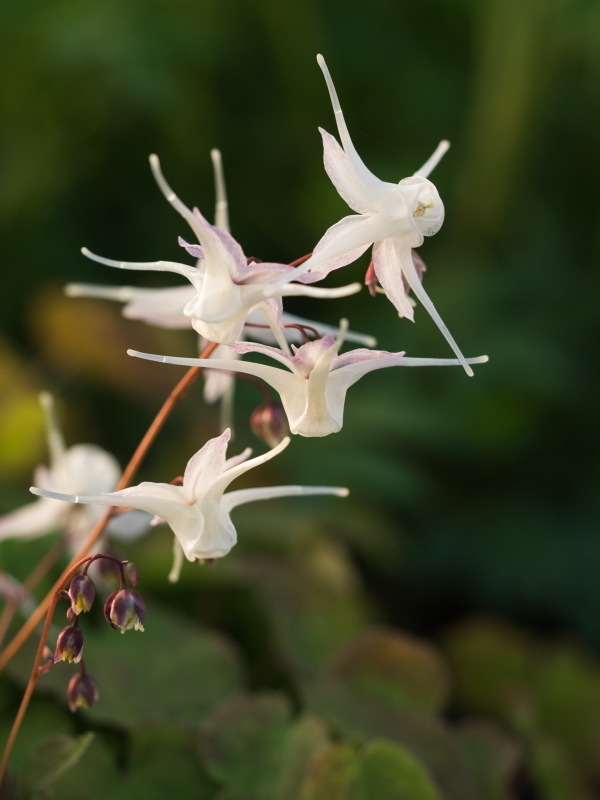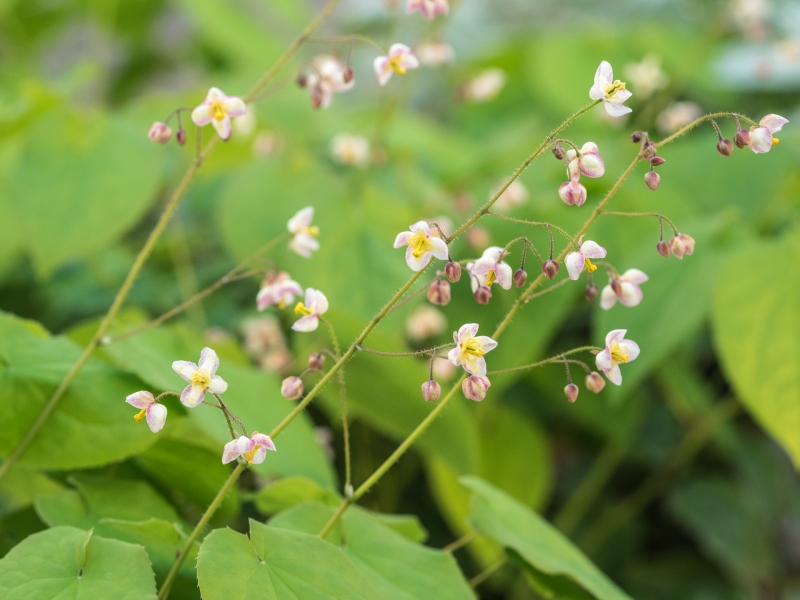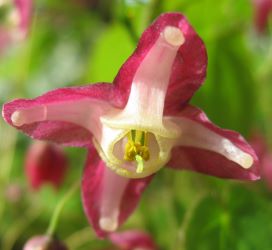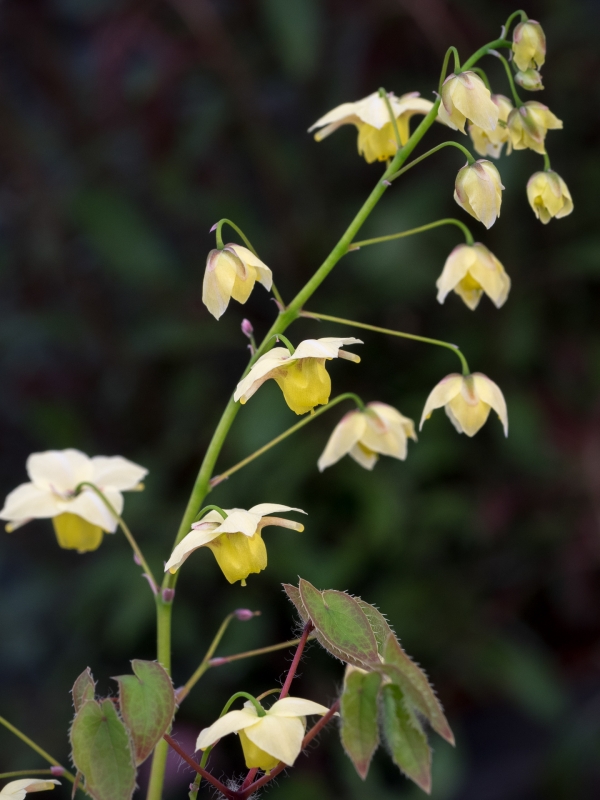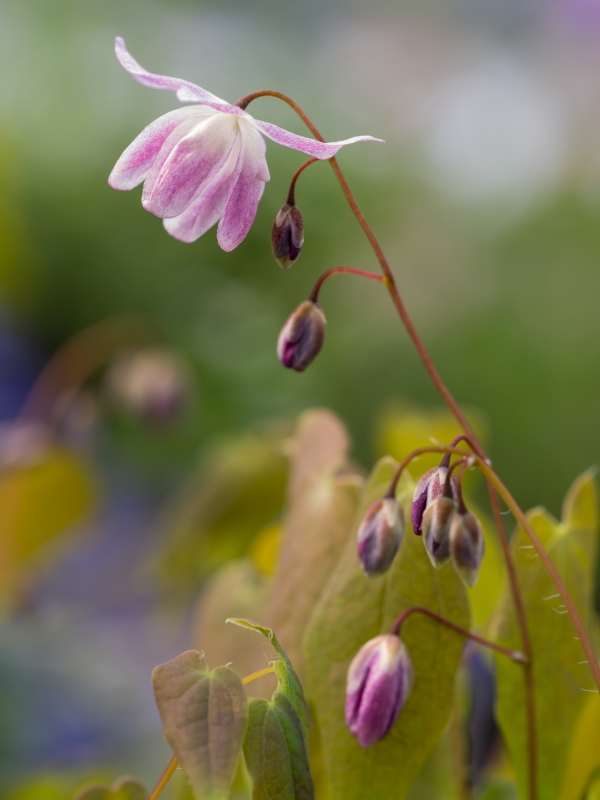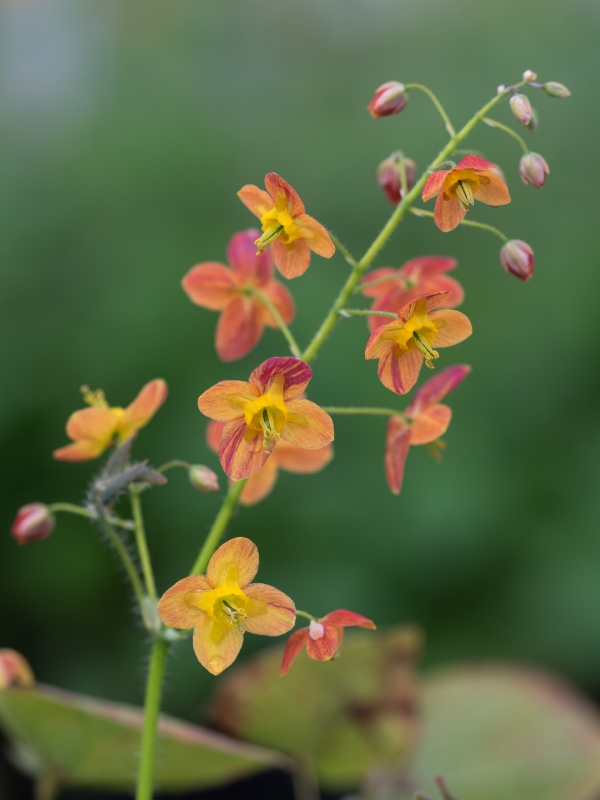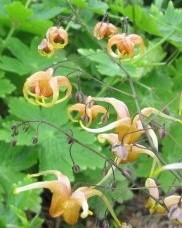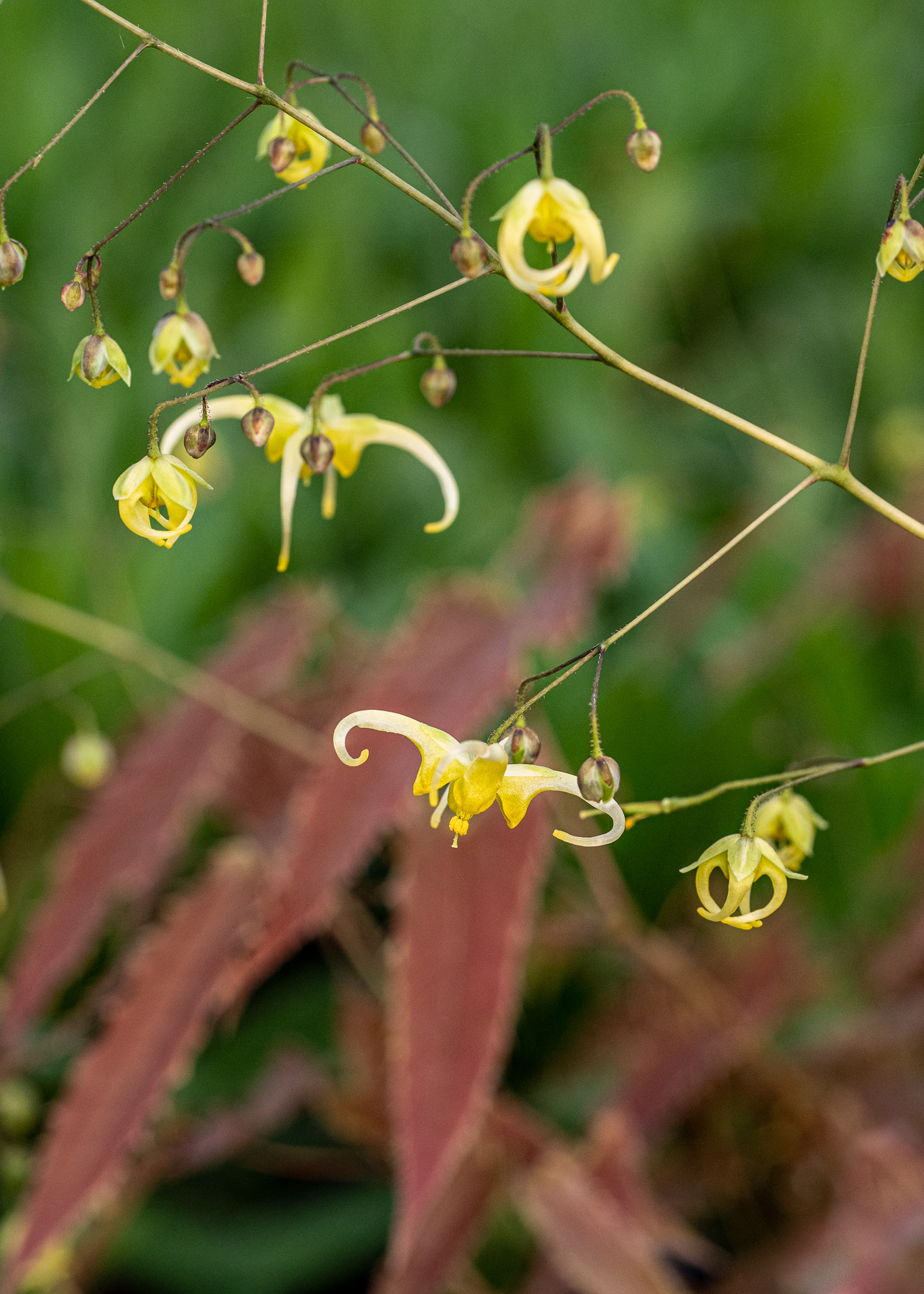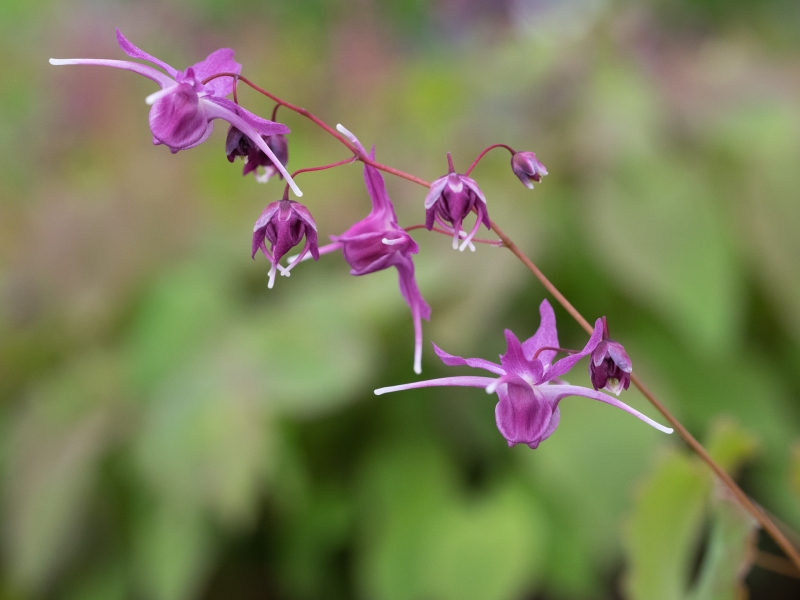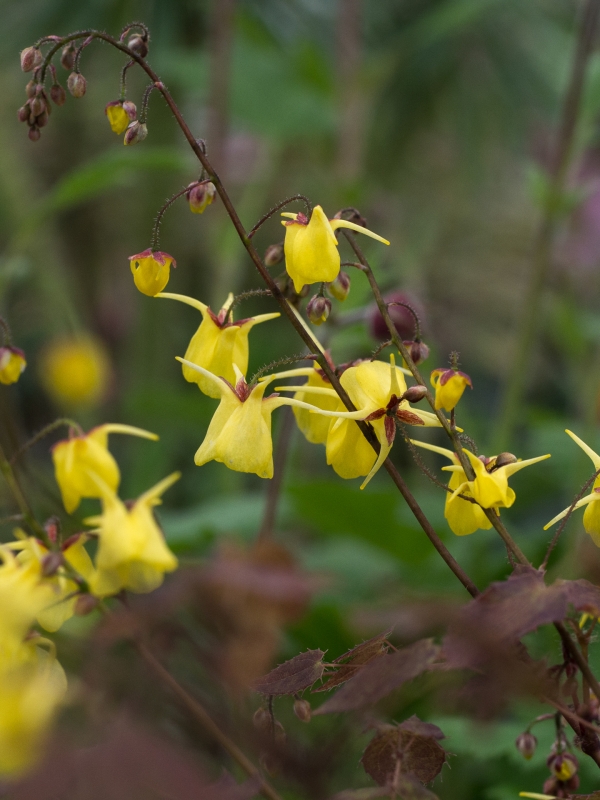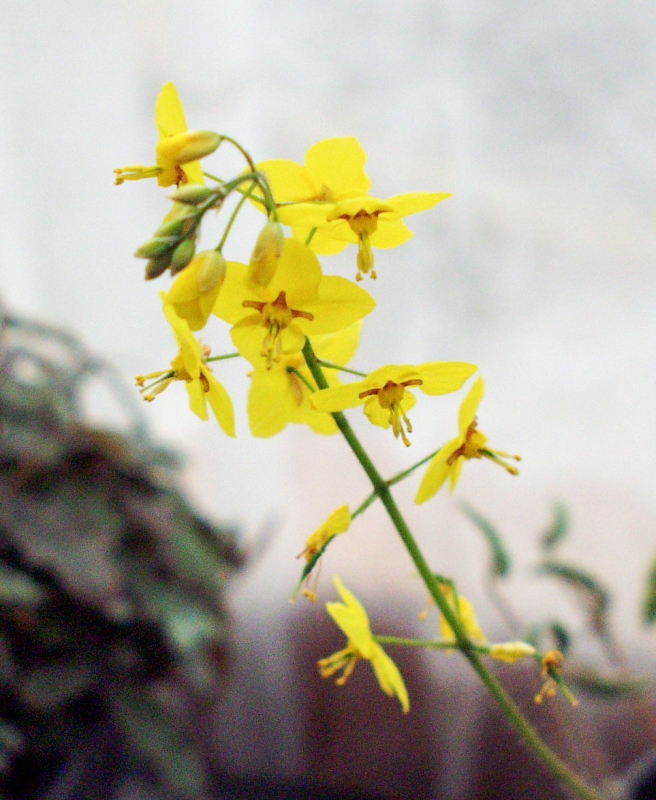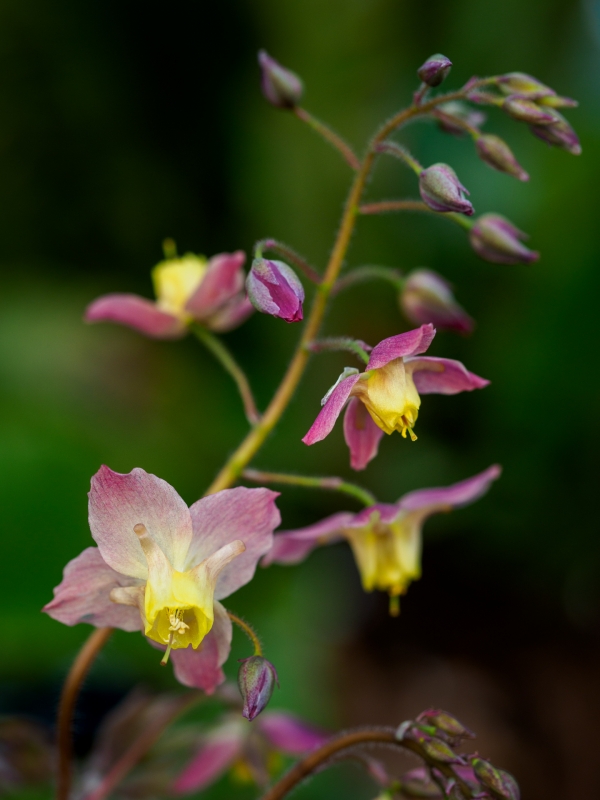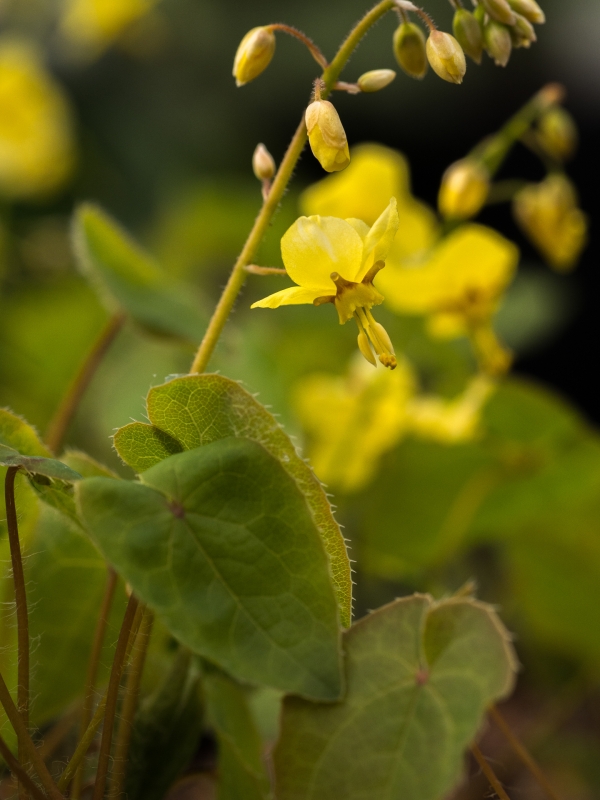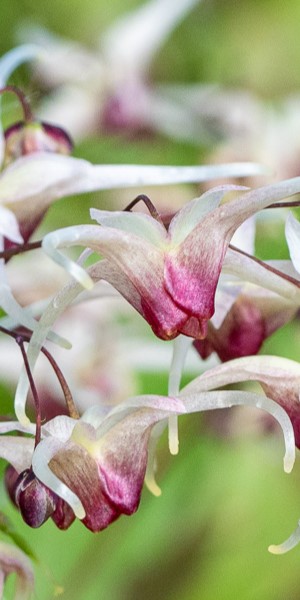Epimedium
Epimedium
This highly collectable genus was named by Carl Linnaeus in 1753 when he described Epimedium alpinum. However Chinese Epimedium are relatively new to Western horticulture, most having been introduced in the last 30 years. New hybrids are introduced each year and some of the colour combinations are spectacular.
Epimedium are low growing, rhizomatous perennials that do well in most soils and are adapted to semi-shady or woodland conditions. Some are drought tolerant but ideally most would prefer moist, humus rich soil and dappled shade. There are even a few that like sun or acid conditions.
Flower petals are arranged in fours and shapes can range from the typical ‘Jester's hat’ style with a central cup and spur shaped petals, to cup shaped bells. Many have evergreen foliage that changes colour throughout the seasons, others are deciduous.
Flower colours range from white through, yellow, amber, orange, red, pink, purple, lilac and brown. Many having combinations of colours. Some produce their most attractive colour in their young foliage.
Flower sizes also vary, and some plants are particularly floriferous and can also produce a second flush.
It is hardly surprising that all this variety has made avid collectors of so many of us.
Height x Spread: 40cm x 45cm
Beautiful large white flowers appear on this plant in mid spring as the new foliage starts to emerge. The young foliage has a bronze tint which contrasts well with the flowers.
The leaves then increase in size and become mid-green in colour, creating good ground cover under trees and shrubs. These plants are deciduous, and the leaves take on wonderful autumnal hues before they fall. They will tolerate dry shade once established. This Epimedium offers great value with both its stunning flowers and colourful foliage.
Height x Spread: 30cm x 45cm
The small clusters of cream flowers of this Barrenwort are held well above the emerging bright green spring foliage.
The individual leaves, which are quite round in shape, are semi-evergreen making this a useful ground-cover plant for shady areas. The old foliage should be removed in early spring to reveal the flowers and new leaves as they appear to appreciate the full beauty of this plant.
Height x Spread: 30cm x 60cm
An older garden variety of Epimedium that is still really worthwhile growing, it is a great plant for shady borders and it's easy to grow. The pretty pink and white flowers are held above the fresh green spring foliage.
As it is evergreen, in the winter months the foliage is still a feature. In the spring it is best to cut off the winter foliage to allow the new flower and foliage shoots to emerge easily.
Epimedium x versicolour 'Sulphureum'
Height x Spread: 30cm x 60cm
A wonderful reliable old variety that creates large swathes of greenery under trees and shrubs giving year-round interest in the garden. The dainty soft yellow flowers appear in mid spring over bronze tinted young foliage.
It is easy to grow and makes a great ground cover plant for shade. As with the other evergreen Barrenworts it is best if the winter foliage is cut off before the new growth emerges in the spring.
Epimedium x youngianum ‘Roseum’
Height x Spread: 30cm x 45cm
This Epimedium produces dainty pale pink to lilac flowers over heart shaped leaves in spring. The plant will form tight clumps and is deciduous with the leaves having good autumnal tones.
It is ideal for combining in a shade container or the front of a shady border in most soil types.
Epimedium x warleyense ‘Orangekonigin’
Height x Spread: 30cm x 40cm
The sweet orange flowers of this Epimedium are quite small individually, but as they appear in clusters, they show up really well over the mid green leaves.
This is a spring flowering plant for shady borders. It creates good clumps quite quickly; it is an easy plant to grow in most soil types and is happy to grow in partial shade or sun - an ideal plant for small gardens where year-round interest is desired.
Height x Spread: 45cm x 60cm
Epimedium 'Amber Queen' has become very popular for its exquisite and prolific display of delicate spurred flowers in spring, each pale yellow flushed with amber, somewhat reminiscent of a jester's hat. It’s neat, heart-shaped foliage is equally delicious, emerging fresh green in spring suffused with red before maturing to dark green.
Happiest if planted in a moist, humus-rich soil with some drainage in light dappled shade, 'Amber Queen' can also tolerate slightly drier soil conditions, neatly solving that difficult conundrum 'What can I underplant trees with?' Works for shrubs too. Tough and hardy if protected from cold desiccating winds, it bulks up slowly, keeping the weeds down at the same time.
Height x Spread: 30cm x 45cm
This plants’ spring display of larger dusky pink flowers with delicate white spurs really lifts the soul on a cold grey day. As the sepal and petals are about the same length, the flowers appear almost double.
A good choice then if you want to add impact with a splash of early season colour to a lightly shaded garden area, but your soil needs to be humus-rich and moist with some drainage for it to thrive. It can tolerate drier conditions, including underplanting trees and shrubs, if treated to an annual mulch of organic matter. Fresh green foliage follows the flowers delivering multi-seasonal interest plus useful, non-invasive ground cover.
Height x Spread: 30cm x 40cm
Why 'Spine Tingler'? It must be for the unusual spiny tipped saw-toothed edge to its semi-evergreen elongated leaves, a hint of 'something of the night'. Initially glossy and reddish bronze when they open, they mature to a dark green over the summer. The flowers are striking, like fine spiders with narrow curved petals in pale lemon to lime, they appear in early spring and can last into early summer.
Found in China by plant collector Daniel Probst and introduced in 2008, this is a very hardy and hard-working plant. Preferring a humus-rich, moist but free draining soil in part shade it can tolerate full shade too. Ideal for underplanting trees and shrubs, we recommend planting it in large groups through a woodland garden, its remarkable flowers shining out of the gloom. Cut back carefully any old foliage in January to reveal the flowers and new foliage.
Epimedium grandiflorum ‘Lilafee’
Height x Spread: 30cm x 45cm
The large pink-purple spurred flowers of this Epimedium appear in mid spring just as the new leaves emerge.
These plants are really good for shady areas of the garden including dry soils, where with care they will establish well. This variety is deciduous, and the leaves have good autumnal tones until the start of winter. This plant prefers slightly acidic soil.
Height x Spread: 25cm x 30cm
Small, bright yellow flowers like jesters' hats dance on wiry stems above a mound of heart-shaped evergreen foliage, copper when young maturing to green and gently ragged around the edges.
Originating from Sichuan Province in China, this is a quite unfussy, easy to grow plant. It prefers a rich, moist but free-draining soil in partial shade, but can also cope with more sun and a marginally drier soil. Great for providing year-round interest in that difficult shady spot of the garden.
Epimedium x perralchicum ‘Frohnleiten’
Height x Spread: 40cm x 45cm
'Frohnleiten' flowers in mid spring producing bright yellow flowers with a red-brown centre. They stand out well against the evergreen foliage, which is a glossy green.
It is best if the old winter foliage is removed pre-flowering to highlight the new flowers as they emerge. Plant them in full or part shade and these plants will flourish in most soil types.
Epimedium x versicolour ‘Cupreum’
Height x Spread: 45cm x 60cm
Epimedium are great 'go-to' plants for a shady garden, ever so delicate but also tough. 'Cupreum' stands out from the crowd not only for its pale pink and yellow flowers graced with elegant spurs, but also its distinctive colourful semi-evergreen foliage.
The flowers appear in early spring lasting well into April, swiftly followed by bright brick-red new foliage with fresh green veins. As summer progresses this matures to green before developing rich reddish-brown autumnal tones. Preferring a partially shaded site away from desiccating cool winds, it makes very useful and attractive groundcover, but also works well in containers on the north or eastern side of a house. To thrive it needs a rich, fertile moist but free-draining soil, but 'Cupreum' once established can tolerate a slightly drier soil.
Epimedium pinnatum subsp. ‘Colchicum’
Height x Spread: 30cm x 45cm
Delicate sprays of small, vivid yellow flowers appear in mid to late spring above a spreading mat of heart-shaped evergreen foliage.
This plant is far tougher than its graceful flowers suggest. It can survive hard winters in the UK, if sheltered from cold drying winds and planted in a moist, free draining soil, which is also nutrient and humus rich. Thriving in partial shade, it is ideal for adding texture and colour to a woodland garden, but also makes unusual and very attractive groundcover. Removing old leaves to ground level in late winter helps to showcase the flowers even more.
Height & Spread 60cms x 100cms
This 2004 introduction is a vigorous plant that is happiest in shade or semi-shade, and once established is quite drought tolerant. The leaves are semi-evergreen, spiny, lanceolate and green with burgundy mottling as they age. The flowers resemble the shape of a jesters’ hat and are pink in the centre and white on the spurs. They are held above the foliage from March to May, on fine red stems.
Epimedium have become highly collectable in the last decade and this one of the most vigorous, a mature specimen can produce approximately 100 flowers in a season and can even produce a second flush if the conditions are favourable. To get the best display place it in fertile, humus rich soil that is moist but well drained and cut the old foliage back in late Winter.
This plant is of no interest to deer, but rabbits can find it attractive, it has very few other problems with pests or diseases, it is also very hardy, having been successfully grown through a Winter of -20C in Scotland.

